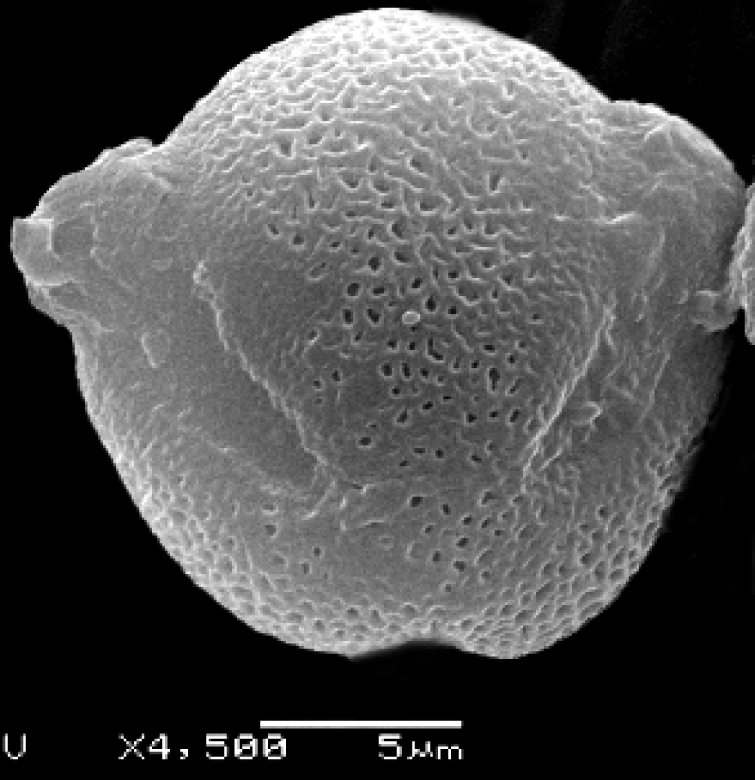Comparative palynomorphological investigation of the representatives tribe Antirrhineae Dumort. (Veronicaceae Durande)
Abstract
Pollen grains of 22 species from 6 genera of the tribe Antirrhineae (Veronicaceae) were studied using light and scanning electron microscopy. Pollen grains of the studied species are 3-colporate, prolate, spheroidal and oblate-spheroidal, small and middle-sized. It is established that pollen grains are characterized by the common sculpture type, which is reticulate. Diagnostic features at the genus level are the structure of apertures and sculpture, shape and size of pollen grains. Pollen morphology supports the suggestion of a close relationship between Linaria, Antirrhinum, Misopates and Cymbalaria. The genera Chaenorhinum and Kickxia have the distinctive palynomorphological characters.
References
Иванина Л.И. 1981. Сем. Scrophulariaceae Juss. – Норичниковые. Флора европ. части СССР. Т. 5: 201–311. Наука, Ленинград.
Куприянова Л.А., Алешина Л.А. 1972. Пыльца и споры растений флоры европейской части СССР. Т. 1. Наука, Ленинград.
Токарев П.И. 2002. Морфология и ультраструктура пыльцевых зерен. Т-во науч. изд. КМК, Москва.
Albach D.C., Meudt H.M., Oxelman B. 2005. Piecing together the «new» Plantaginaceae. Amer. J. Bot. 92 (2): 297–315.
Elisens W.J. 1986. Pollen morphology and systematic relationships among New World species in tribe Antirrhineae (Scrophulariaceae). Amer. J. Bot. 73 (9): 1298–1311.
Erdtman G. 1952. Pollen morphology and plant taxonomy. Angiosperms. Almqvist & Wiksell, Stockholm.
Moore P.D., Webb J.A. 1983. An illustrated guide to pollen analysis. Hodder & Stoughton, London.
Karim F.M., El-Oqlan A.A. 1989. Palynological studies in the family Scrophulariaceae from Jordan and Iraq. Pollen et Spores 31: 203–214.
Minkin J.P., Eshbaugh W.H. 1989. Pollen morphology of the Orobanchaceae and rhinanthoid Scrophulariaceae. Grana 28: 1–18.
Olmstead R.G., DePamphilis C.W., Wolfe A.D. et al. 2001. Disintegration of the Scrophulariaceae. Amer. J. Bot. 88 (2): 348–361.
Oxelman B., Kornhall P., Olmstead R.G., Bremer B. 2005. Further disintegration of the Scrophulariaceae. Taxon 54: 411–425.
Takhtajan A.L. 1997. Diversity and classification of flowering plants. Columbia Univ. Press, New York.
Takhtajan A. 2009. Flowering Plants. Springer Verlag.
Tank D.C., Beardsley P.M., Kelchner S.A., Olmstead R.G. 2006. Review of the systematics of Scrophulariaceae s.l. and their current disposition. Austral. Syst. Bot. 19: 289–307.


This work is licensed under a Creative Commons Attribution-NonCommercial-NoDerivatives 4.0 International License.
The journal is licensed by Creative Commons under BY-NC-ND license. You are welcome and free to share (copy and redistribute the material in any medium or format) all the published materials. You may not use the material for commercial purposes. You must give appropriate credit to all published materials.
The journal allow the author(s) to hold the copyrights and to retain publishing rights without any restrictions. This is also indicated at the bottom of each article.





